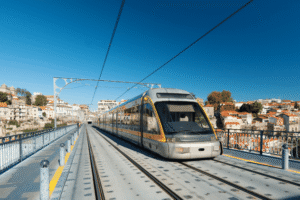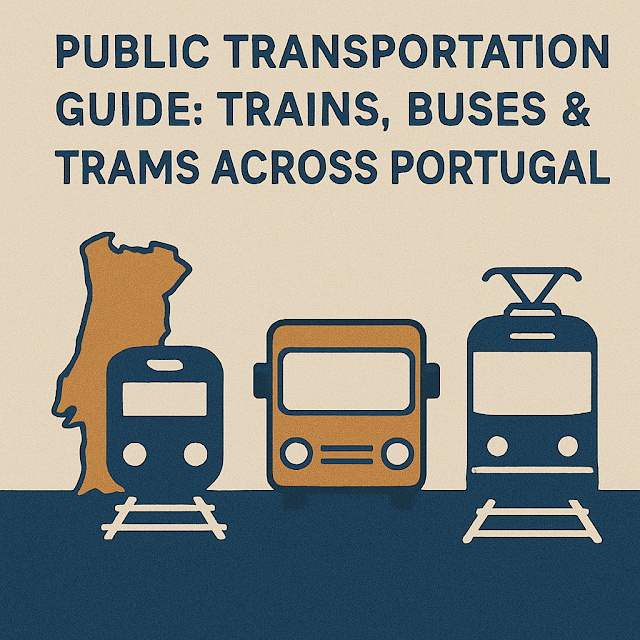Public Transportation Guide in Portugal: Whether you’re moving to Portugal or planning a long-term stay, understanding the public transport options is essential for navigating the country efficiently. From high-speed trains to charming trams, Portugal offers a wide range of reliable and affordable transport services. This 2025 guide dives deep into each mode of public transport so you can travel with confidence.
🚆 Train Travel in Portugal

Trains are a popular and scenic way to travel across Portugal. The national train company, Comboios de Portugal (CP), runs regional, intercity, and high-speed trains.
- Urban and Regional Trains: Great for short distances and daily commuting in cities like Lisbon and Porto.
- Intercidades (Intercity Trains): Comfortable long-distance trains connecting major cities.
- Alfa Pendular: The fastest trains linking Lisbon, Porto, Coimbra, and the Algarve.
Train Prices: Fares range from €5 to €40 depending on distance and class.
Where to Book: Online at cp.pt, at stations, or via the CP mobile app.
🚌 Intercity and Regional Buses
When trains aren’t available or convenient, buses are an excellent alternative. Several companies serve cities and towns across Portugal:
- Rede Expressos: Main national carrier with routes to most cities and towns.
- FlixBus: Offers budget-friendly travel and connections to Spain and beyond.
- Eva Transportes: Focuses on southern Portugal, especially the Algarve.
Bus Prices: Tickets cost between €6–€25 for intercity trips.
Where to Book: Company websites, ticket counters, or bus station kiosks.
🚋 City Public Transport: Trams, Metros, and Buses
Lisbon, Porto, and other cities offer extensive public transport networks combining metro, tram, and bus services:
Lisbon
- Metro: 4 lines connecting the city center with suburbs.
- Trams: Historic routes like tram 28 are iconic.
- Buses: Operated by Carris, covering most neighborhoods.
Porto
- Metro do Porto: 6 lines reaching the airport and nearby cities.
- STCP Buses: Connect residential zones and metro stations.
Tickets & Passes: Use a Viva Viagem or Andante card for easy top-up access. Monthly passes range from €30 to €50.
🚖 Taxis, Uber, and Bolt
Taxis are widely available and regulated, but ride-hailing apps like Uber and Bolt are often cheaper and more convenient.
Fares: Start at ~€3 with rates around €0.50–€0.70/km. Prices may rise in touristy or remote areas.
⛴️ Ferries and River Transport
Ferries are useful in cities like Lisbon and between mainland Portugal and the islands:
- Lisbon: Regular ferry routes cross the Tagus River to Barreiro, Seixal, and Cacilhas.
- Island Ferries: Services operate between Madeira, Porto Santo, and the Azores.
Fares range from €2–€10 for urban ferries and more for island trips.
💡 Tips for Using Public Transport in Portugal
- Always validate your ticket before boarding (especially on trains and trams).
- Apps like Moovit, Rome2Rio, or CP provide real-time info and trip planning.
- Use contactless cards where accepted for quicker boarding.
📍 Regional Travel Highlights
- Algarve: Limited train coverage—buses are often more convenient for travel between beach towns.
- Madeira: No trains; public buses connect main towns and Funchal airport.
- Azores: Rely on buses and taxis; inter-island travel via ferry or short flights.
✅ Final Thoughts
Portugal’s public transport network is reliable, clean, and budget-friendly. Whether you’re commuting daily, taking weekend trips, or exploring new regions, the combination of trains, buses, metros, and ferries will get you where you need to go. A little planning and the right travel card can make a big difference in comfort and savings.
